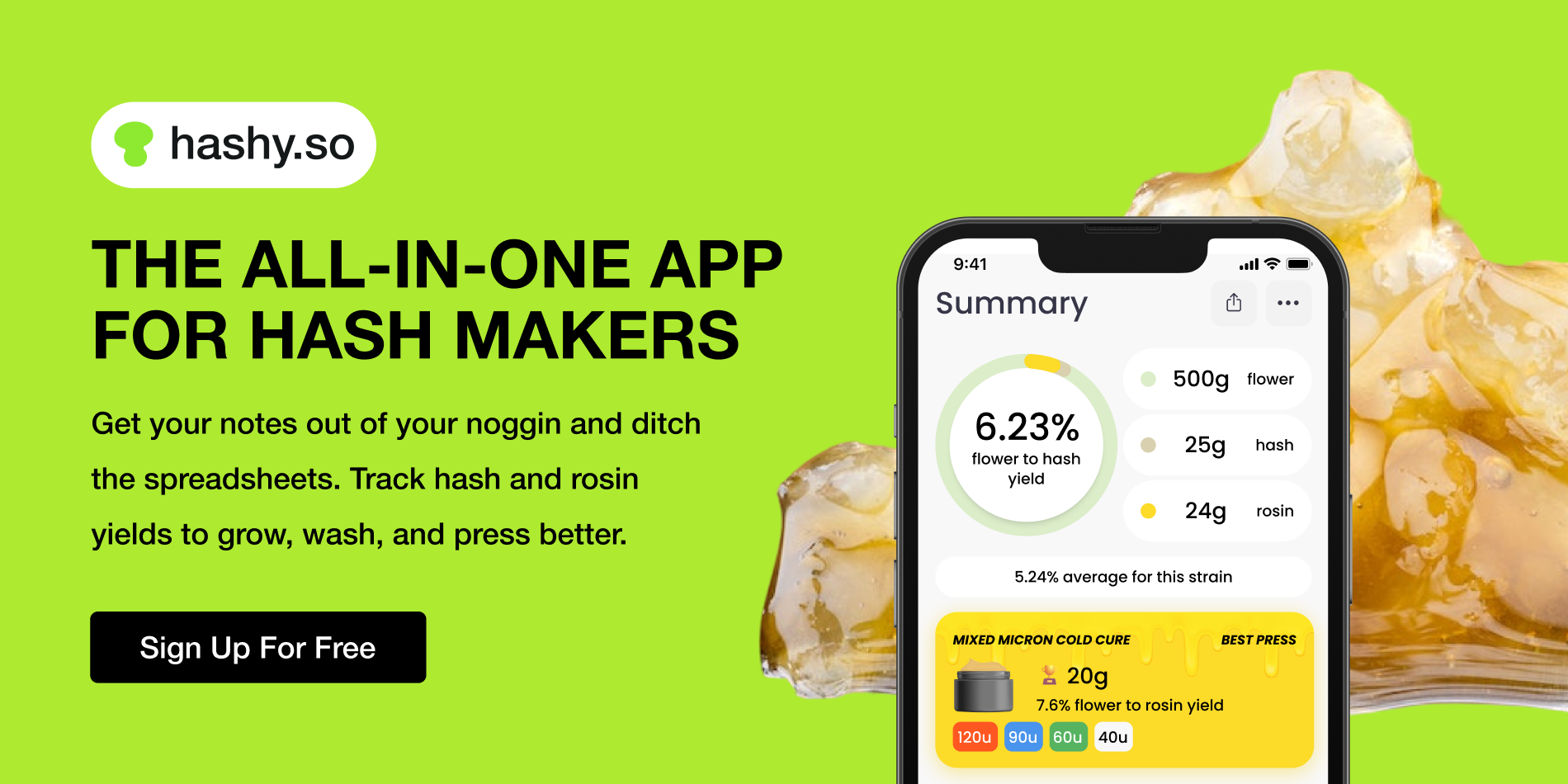

Resin farming and processing is a symphony of variables. Terroir, genetics, processing tech, and millions of other factors.
And if you want to make decent hash – you have to nail each and every one. Anywhere you look, you'll see content talking about yields.
"My GMO yielded 5.5%"
"I got 86% back on this Tropicanna Cake"
First of all, what does that even mean? Are you talking about the entire spectrum of resin or only the best heads? What is the moisture level of your starting material? What was the cannabinoid content of your yields?
There is zero standard when it comes to talking about rosin yields. And there's even less of a benchmark when it comes to actually calculating them.
Online tools and a pocket calculator are a good start, but they're missing the full picture. Let's talk about taking a more holistic approach to data capture and yield tracking for making more effective production decisions.
Online tools and templates reduce rosin and hash production to one simple equation: input, output, yield.
Looking at rosin yields like this overlooks many variables that impact the true quality and quantity of your final product. Press times, temperatures, bag sizes, pre-press procedure, pressure curve, and bag loading tech are just as important to capture and discuss when you're evaluating yields or the viability of running a certain material.
A cultivar with mostly ~45u and ~120u heads might deliver excellent yields but
Let's say you're running two phenos of Banana OG.
Pheno #1 dumps 45u and 120u but leaves barely any 90u. Total 10g.
Pheno #2 yields a lot less, but it's all in 90u. Total only 4g.
At first glance -- that Banana OG #2 is useless compared to #1 yield-wise. Dive in a little deeper and maybe that 45u/120u turns out tasting like dog shit.
Suddenly that tasty 90u from #2 looks a lot more appealing, even though the batch yielded lower as a whole.
This is a very oversimplified example, but it illustrates why it's important to look at other factors when you're calculating rosin yields.
Don't want to miss out on fire pheno selection by evaluating decisions based on generic "yield" numbers.
When calculating rosin yields, it's crucial to consider the following factors:
The moisture content of your starting material has a massive impact on initial starting weight, and in turn, your yield numbers. This is vital to factor in when you're evaluating the viability of different flower. If you're running a single source operation and following the same flush/chop/freeze procedure for all of your material, then you may have consistency with moisture content without having a specific measurement. It's a little more problematic for hash makers that are working with other farmers to process their material as they don't usually all follow the same process, and therefore their moisture contents (and subsequent yield numbers) could be wildly different.
Tracking your flower to hash yield is valuable to understand the relationship between resin and biomass. Separating out washes and bags for individual weighing during initial test washes is particularly important even if you plan on running full spectrum down the road, so you can better understand that material's trichome composition.
Calculating your hash to rosin yields will help you optimize your pressing technique for maximum quality and output. You could be under extracting and discover that adding a bit more heat drastically increases the amount of rosin you're getting out. Looking at hash to rosin yields across different control materials also allows you to paint a more detailed picture about those trichomes, their size, cuticle thickness, and how much stalk is coming through.
This is a vague way of saying it's not all about a single yield number for your flower/hash/rosin. How that resin tastes, looks, and dabs is always going to be the most important marker. Yields will never matter if it tastes like garbage, which is why it's so critical to measure specific spectrums of heads, and to test the final content of your hash or rosin to understand what cannabinoids and terpenes you're actually yielding.
Fine-tune your wash times, micron combinations, drying tech, pressing, and material selection. Create a more transparent relationship with your cultivators to grow better resin.
Most importantly — see how and where you’re losing time and yields so you can iterate.
Going beyond basic yield percentages allows you to focus on other areas of resin cultivation in processing that are equally important, like flavor, stability, and effects.
The specific sizes of heads that a plant is growing, and that you’re capturing during the wash process, are especially crucial to consider because this will have a large impact on what you end up sending to melt, food grade, or various rosin tiers.
If you’re running a craft brand or trying to win awards, paying attention to this level of detail can help you steer your product in very specific ways to give you that edge.
Understanding the full scope of your yields leads to more accurate cost calculations and better inventory management. Tracking other parts of the process can show if you’re using an improper bag set up or drying with the wrong parameters or messing up your presses.
This is where it can be important to understand the moisture content of your starting material in order to evaluate different cultivators on even footing.
Taking a more in-depth approach to yield tracking is really helpful when you want to pick winning genetics for specific product applications.
Again, having that understanding of exactly what head sizes are coming off, how thick the cuticles are, and how long the stalks are, and what the final content of the resin is, makes it way easier to select for full, melt, or rosin cartridges, etc.
Mastering solventless is like conducting a symphony — requiring a detailed understanding of how all the variables harmonize. Rosin yield calculators are a good starting point but they don’t paint the full picture you need in order to keep elevating your craft.
You’re an artist. Let’s stop defining resin by a single yield number and bring other variables into the conversation.

Spreadsheets, paper, notes, and existing manufacturing ERPs could be super helpful if you want to start analyzing your data.
If you really want to step it up, you should try to find a solution that’s optimized for your specific solventless process.
We found that a lot of the existing ERPs could be pretty hard to set up and dial-in to show the data you actually need. And it goes without saying that most of them are optimized for big BHO production, and not for small batch hash makers.
We’re focused entirely on making the best software for solventless specifically. Here’s how we’re doing it..
Intuitive Data Entry: You can connect existing lab gear on and our UI is built to look like the tools you use every day.
Visualize Results: Ditch spreadsheets for graphics anyone can understand.
Compliance Simplified: Spend significantly less time dealing with compliance by keeping all of your info in one place.
By using dedicated solventless software, you can have a better understanding of your processes, yields, and the quality of your product. These tools provide a more comprehensive and precise approach, allowing you to make informed decisions that could potentially improve your operations, quality control, financial planning, and genetic selection.
It's not just about the yield. It's about understanding all the variables and factors that go into creating a quality product. After all, as an artist in the world of solventless resin, your ultimate goal is to elevate your craft, bringing the best possible product to market. And taking a holistic approach to data capture and yield tracking is a crucial step in that direction.